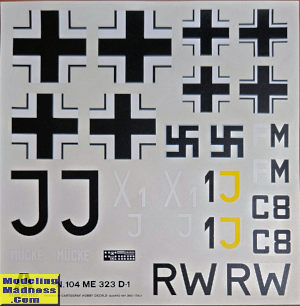
Italeri 1/72 Me-323 Gigant
| KIT #: | 104 |
| PRICE: | $ |
| DECALS: | Two options |
| REVIEWER: | Scott Van Aken |
| NOTES: | 1980 release |

| HISTORY |
Early in 1941, as a result of feedback from Transport Command pilots in Russia, the decision was taken to produce a motorized variant of the Me 321, to be designated Me 323. French Gnome et Rhône GR14N radial engines, rated at 1,180 PS (1,164 hp, 868 kW) for take-off as used in the Bloch MB.175 aircraft were chosen for use. This would reduce the burden on Germany's strained industry.
Initial tests were conducted with four Gnome engines attached to a strengthened Me 321 wing, giving modest speed of 210 km/h (130 mph) – 80 km/h (50 mph) slower than the Ju 52 transport aircraft. A fixed undercarriage was fitted, with four small wheels in a bogie at the front of the aircraft and six larger wheels in two lines of three at each side of the fuselage, partly covered by an aerodynamic fairing. The rear wheels were fitted with pneumatic brakes that could stop the aircraft within 200 m (660 ft).
The four-engined Me 323C was considered a stepping-stone to the six-engined D series. It still required the five-engined Heinkel He 111Z Zwilling or the highly dangerous "vic-style" Troika-Schlepp formation of three Messerschmitt Bf 110 heavy fighters and underwing-mounted Walter HWK 109-500 Starthilfe rocket assisted takeoff units to get airborne when fully loaded, but it could return to base under its own power when empty. This was little better than the Me 321, so the V2 prototype became the first to have six engines and flew for the first time in early 1942, becoming the prototype for the D-series aircraft.
To reduce torque, the aircraft was fitted with three counterclockwise rotation engines on the port wing and three clockwise rotation engines on the starboard wing, as seen looking forward from behind each engine - resulting in the propellers rotating "away" from each other at the tops of their arcs. Over 200 Me-323 aircraft were built.
| THE KIT |
 This
is a bit of an old school kit in that most of the surface detail is raised. It
also has a rather impressive parts count of 340 pieces, many of them fairly
small as they are things like control surface hinges and bits for the landing
gear and wheels. Italeri has also provided a full cabin so you have all the
bracing required for the inside. There are also a lot of small transparencies
that fit on the inside of the fuselage halves.
This
is a bit of an old school kit in that most of the surface detail is raised. It
also has a rather impressive parts count of 340 pieces, many of them fairly
small as they are things like control surface hinges and bits for the landing
gear and wheels. Italeri has also provided a full cabin so you have all the
bracing required for the inside. There are also a lot of small transparencies
that fit on the inside of the fuselage halves.
The cockpit is fairly well appointed, though a bit generic and you are provided with crew members. The upper wing is in six sections with two for the center section and four for the outer pieces. All of the control surfaces are separate as well and while designed to be posed in the neutral position, could probably be repositioned if you wished.
 The kit
provides six rocket assist units along with their mounting braces. You also have
six engines, props and nacelles to build, so this will not be a weekend build by
any means. The nose doors can be posed open if you wish.
The kit
provides six rocket assist units along with their mounting braces. You also have
six engines, props and nacelles to build, so this will not be a weekend build by
any means. The nose doors can be posed open if you wish.
Instructions are well done and provide RLM numbers for the paint colors. Two markings options are provided. One is the box art plane on the eastern front in RLM 70/71/65. The other is from Tunisia in RLM 71/65 with sand colored patches. Decals may be usable, but I'd consider them suspect. The instructions have photos of the real deal to perhaps provide some diorama inspiration.
| CONCLUSIONS |
One thing for sure is that even in 1/72 scale, this one will take time to build and will require some shelf space to display. This aircraft has been done in 1/144 and 1/48 but as far as I know, this is the only 1/72 option. If you wanted to do the glider version, you could do so by simply leaving off the engine assemblies.
| REFERENCES |
https://en.wikipedia.org/wiki/Messerschmitt_Me_323_Gigant
May 2024 Copyright ModelingMadness.com. All rights reserved. No
reproduction in part or in whole without express permission from the editor. If you would like your product reviewed fairly and fairly quickly, please contact the editor or see other details in the
Note to
Contributors.